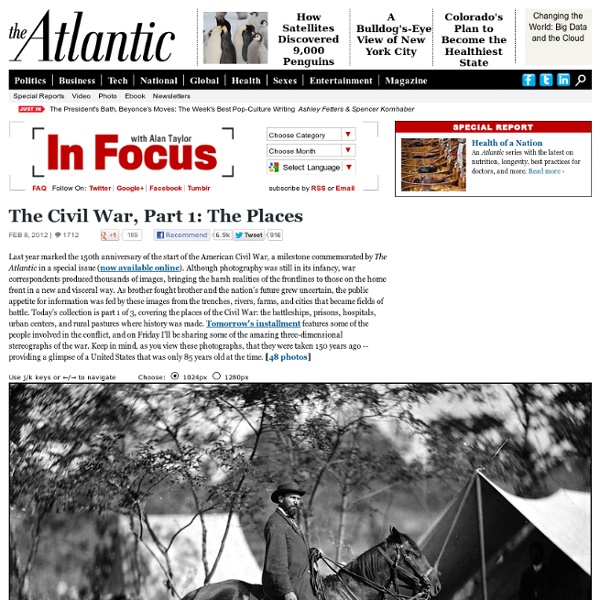U.S. History: Free streaming history videos & activities
The Surveillance Catalog - The Wall Street Journal
As the Internet has grown to handle more data, monitoring companies have had to keep up. Interception now can mean taking all the traffic from the Internet backbone and funneling it through devices that inspect the packets of data, determine what is inside them, and make decisions about whether to copy them for law enforcement.
Over the Top - A First World War Free Online Adventure Game
Introduction Over the Top is an interactive adventure game that allows YOU to experience life in the trenches during the First World War. As a young Canadian soldier stationed somewhere along the Western Front in the late Fall of 1916, you will live through some of the excitement, despair, brutality and sheer horror of trench warfare. Over the Top is based on the real-life experiences of Canadians who lived and died in the trenches during the First World War. Throughout the story, you will come across many words and expressions that were quite common at the time. Your goal in Over the Top is the same as that of thousands of Canadians who served in the trenches during the First World War: merely to survive. So pick up your rifle, put on your helmet and get ready for a truly unique experience! *Flash Player version 6 required Best viewed at 800x600 resolution Low-Graphics Version Virtual Museum of Canada.
The NSA Is Building the Country's Biggest Spy Center (Watch What You Say) | Threat Level
It needs that capacity because, according to a recent report by Cisco, global Internet traffic will quadruple from 2010 to 2015, reaching 966 exabytes per year. (A million exabytes equal a yottabyte.) In terms of scale, Eric Schmidt, Google's former CEO, once estimated that the total of all human knowledge created from the dawn of man to 2003 totaled 5 exabytes. The data stored in Bluffdale will naturally go far beyond the world's billions of public web pages. Once it's operational, the Utah Data Center will become, in effect, the NSA's cloud. 1 Geostationary satellites Four satellites positioned around the globe monitor frequencies carrying everything from walkie-talkies and cell phones in Libya to radar systems in North Korea. 2 Aerospace Data Facility, Buckley Air Force Base, Colorado Intelligence collected from the geostationary satellites, as well as signals from other spacecraft and overseas listening posts, is relayed to this facility outside Denver. 5 NSA Hawaii, Oahu
Lesson Plans History American Government High School - USHistorySite.com
Why Arctic sea ice shouldn't leave anyone cold - Arctic Sea Ice
The sea ice is leaving us a bit more every year. It's time to start contemplating its absence, which is why I teamed up with Kevin McKinney to write an extended version of the shorter piece you might see pop up here and there. Because you know, disappearing sea ice isn't without consequences. And that's why it shouldn't leave you cold. The first world in ancient Norse mythology, Niflheim, sounds just like the Arctic ice. …sea ice became a feature of the Arctic by 47 [million years before the present], following a pronounced decline [in carbon dioxide concentrations]… Ice was apparently most widespread during the last 2–3 million years, in accordance with Earth's overall cooler climate. Since modern humans are just 200,000 years old, the ice might as well be eternal. But not unchanging. Polyak et al. continues: Nevertheless, episodes of considerably reduced sea ice or even seasonally ice-free conditions occurred... But that has changed. And if it does? Images used:
North Carolina History: A Digital Textbook - LEARN NC
Primary sources, multimedia, readings, and lesson plans to tell the many stories of North Carolina's past. Replace your textbook — or enhance your teaching with selections. Get started Sampler An overview with samples of the kinds of readings, primary sources, and multimedia available. Educator’s Guides Best practices, process guides, worksheets, and other resources for teaching with the digital textbook. Explore by era Precolonial (to 1600) Natural history, American Indians before contact, the Lost Colony, and the Columbian Exchange. Colonial (1600–1763) Migration, government, religion, and daily life from the first successful English colonies to the eve of the Revolution. Revolution (1763–1789) The Regulators, the resistance to Great Britain, the War for Independence, and the creation of new governments. Early National (1789–1836) Politics, society, and culture from the 1790s to the 1830s, including education, reform, and the growth of slavery. Antebellum (1836–1860) Civil War (1860–1876)
Can we expect the economy to keep growing?
If we read the financial pages, economic growth seems to be viewed as the “normal” situation to which economies inevitably return. But is it really? If we look back over the past 50 years, or even over the past 100 years, economic growth has predominated. Over the longer term, we know that people have become more prosperous, and that world population has grown. The natural assumption is that economic growth will continue in the future as it has in the past. Let’s think about this a little further. The question is really where we are now, relative to the hard limits that we know must exist. What is needed to produce goods and services? If we are going to have an economy, we will need goods and services. 1. 2. 4. Once we start moving to larger numbers of people, some type of financial system is needed. Has Economic Growth Always Been Possible? If we look back through history and pre-history, what we see is a long struggle against limits of various kinds. 1. 2. Over time, trade expanded. 3.
History for Kids | Teaching Social Studies | Social Studies for Kids
Solve For X
- George Washington Carver - R. Buckminster Fuller - Arthur C. Clarke - Marie Curie - Albert Einstein



